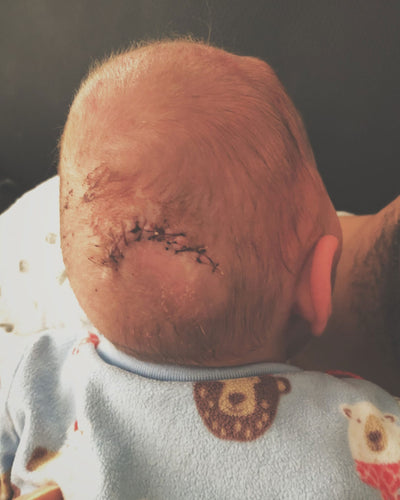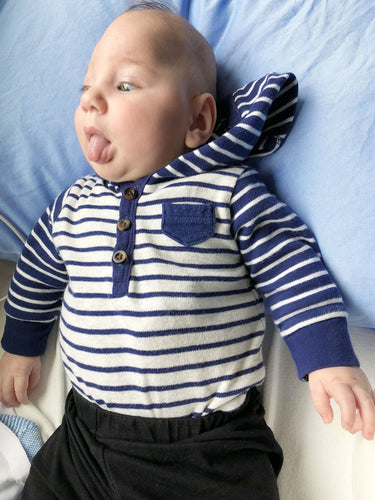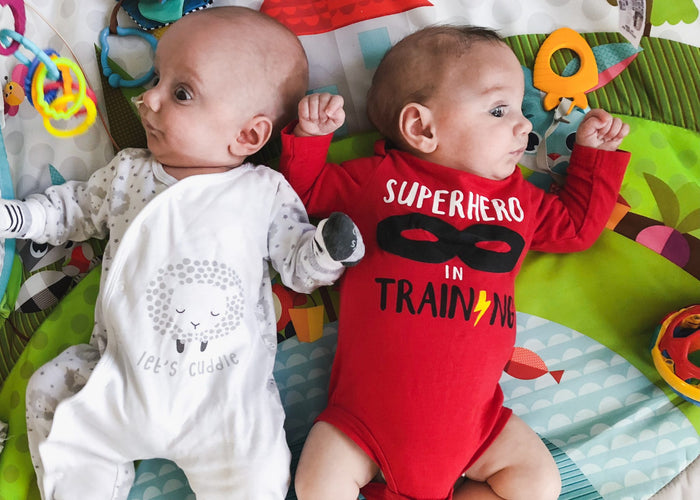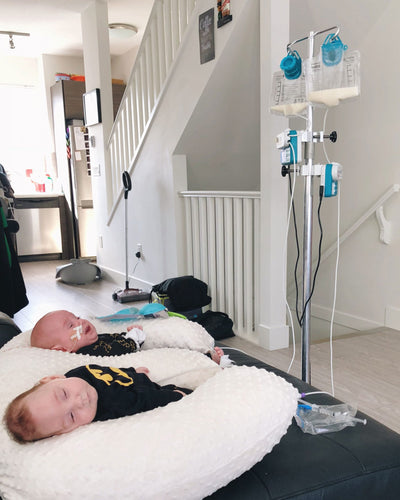A few days after Axel and Jaxon were born at 27 weeks 2 days, we were told they each had brain bleeds. This is also known as an intraventricular hemorrhage.
We didn’t know what that meant.
The doctors explained the 4 grades of brain bleeds and then told us Jaxon had the worst possible: a large Grade 4 bleed on both sides of his brain (“bilateral”). Axel had a Grade 3 on one side and a small/medium Grade 4 on the other side. (It started as a bilateral 4 as well, but one side got downgraded to a 3. Basically, it still is quite severe.)
For this post, I’m focusing on Jaxon’s story only. Axel did end up acquiring hydrocephalus as well from his brain bleed but it is currently not requiring a shunt. The neuro team is watching him closely.
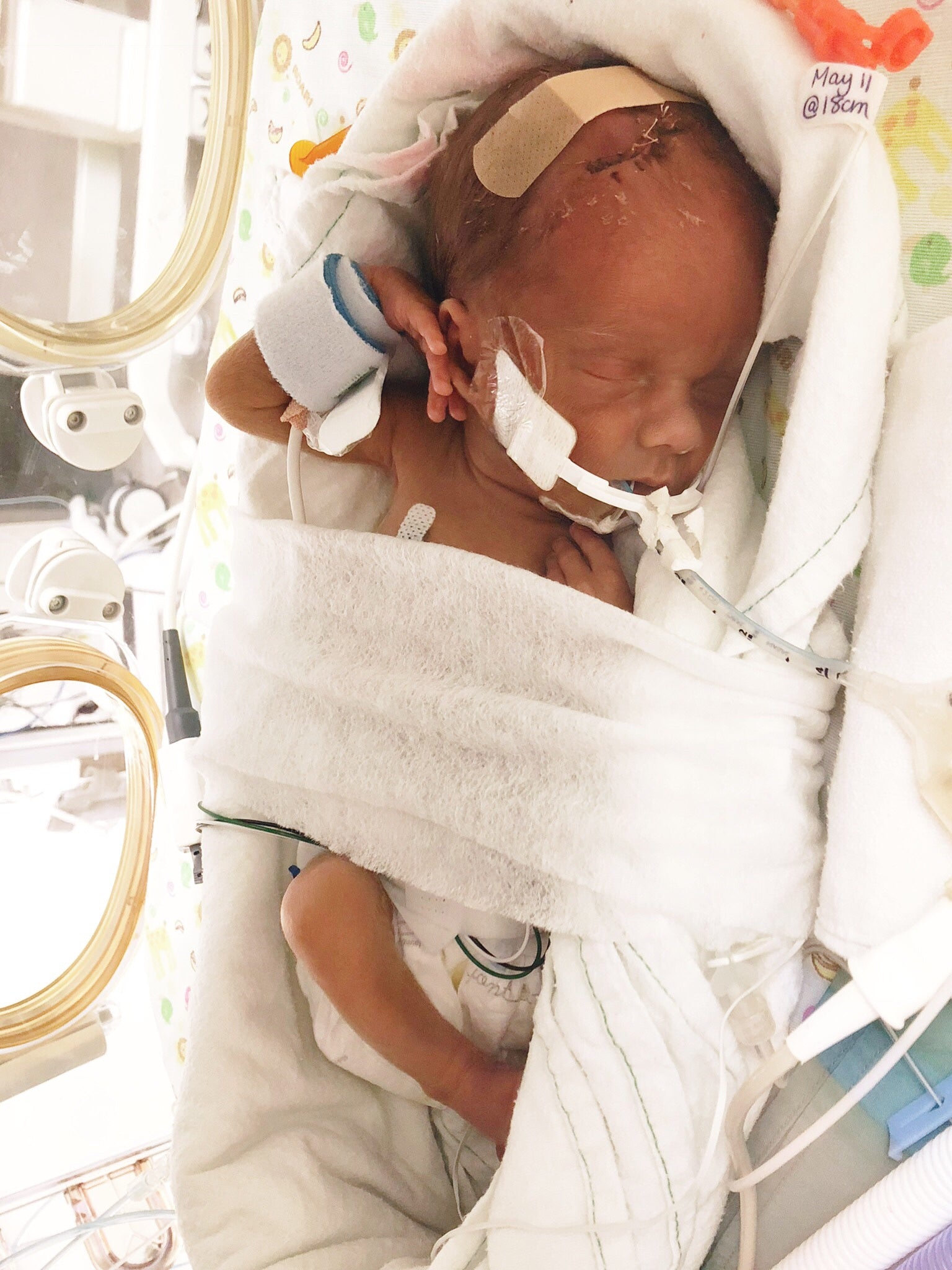
Having the boys be born so premature was already such a shock and so unexpected and, frankly, traumatic. Then to be told a few days after they were born – alive but barely in incubators with countless respirators, IVs, medications and constant alarms and beeps – that the boys had serious brain bleeds… it was really overwhelming.
I want to write Jaxon’s story so far because I want it to give you hope if you’re going through a similar journey with a Grade 4 brain bleed. He is only 4 months old (1 corrected) and it is far too early to say how his bleed will affect him in the future, so this isn’t a long-term inspirational story. But it’s short-term, and maybe that’s enough for you for now.
Finding Out About the Bleed
It was a few days after their birth. I was still in the postpartum recovery ward, in pain from my c-section, and getting wheeled across the hospital to visit my boys in the NICU every chance I got, though I hated having to leave every 4 hours to get my medication back in my room.
All that is to say, it was still a very raw time that felt a bit surreal.
The doctors set up a meeting with us. One of the neonatologists and a resident. I didn’t think much of it. I figured they meet with new NICU families most of the time. I wasn’t oblivious, I knew our boys were sick and it was stressed to us how near death they were several times. But I didn’t know anything about brain bleeds. I just assumed that while all their major organs were under strain right then, that they would heal and eventually be “fine.”
These meetings are not routine.

They told us that Jaxon had a bilateral grade 4 bleed and that he would likely face severe disabilities during his entire life. There is an about 80% chance he will have cerebral palsy, though no one can predict the severity of it if he does. Basically, we won’t know anything is wrong until it shows itself, which could take a few years for motor disabilities or up to five or six years for intellectual disabilities.
They gave us a choice: to continue with intensive care to try to save his life (which we did), or to switch him to “comfort care.” Which focuses on pain management only and is essentially palliative care for neonatal newborns, and is just heartbreaking to think about.
A Grade 4 bleed can actually be fatal on its own. We didn’t really understand at the time how lucky we are that Jaxon is still here, breathing on his own, able to eat (though we still use his G-tube several times a day as well), and able to move (so far, as an infant).

I of course immediately burst into tears. They gave us several days to think about it, but for me it wasn’t really an option at all. We chose to fight for Jaxon. I hope he thinks we made the right choice when he grows up. That is my biggest hope for him: to enjoy his life, whatever it may turn out like.
Jaxon’s Shunt Surgeries
Jaxon has had 3 brain surgeries so far.
His first was at 15 days old (May 11) to put in his “reservoir” as it’s called. Basically it’s a temporary shunt that collects the cerebral-spinal fluid (CSF) so it can be manually drained out. He had this first to see if the hydrocephalus would clear up on its own, so he wouldn’t need a life-long shunt, and also because he was too small for the full VP shunt surgery at just under 3lbs still.


After 50 days of draining the fluid out manually every day with a large needle, it became apparent he would still need a permanent VP shunt. We were devastated to find this out, because shunts have the highest failure rate of any medical device ever made. It means a life full of neurosurgery appointments, MRIs, careful monitoring for shunt failure (breakage) or infection, both of which can be easily fatal if not caught in time.
And, just Jaxon’s luck, his first VP shunt did fail after only 2 weeks.
At 36 weeks gestational age on June 22, Jaxon got his first VP shunt put in. On July 11, he had ANOTHER full shunt put in since the first one broke.


It was a heartbreaking time as he cried endlessly, in pain, and was completely inconsolable for so long. We had to sedate him for his own comfort as we awaited time for him to undergo the 3rd shunt surgery (they waited 2ish weeks because the scar tissue had to heal enough to be able to open him up again).
Now his VP shunt appears to be working great and we are so glad!
- Bilateral grade 4 brain bleeds, classified each as “large”
- Over 50% of his brain was consumed by CSF fluid before his shunt for hydrocephalus
- Encephalomalacia (entirely dead areas of the brain that can never recover, also known as “softening”)
- PVL (periventricular leukomalacia) – loss of white matter around the ventricles
- Basal ganglia injury
- At birth had metabolic acidosis, indicative of hypoxic brain injury (lack of oxygen)
EACH of this conditions can be fatal on their own. Combined like this is… pretty much not seen in a living being. Especially one who can smile, laugh, babble and tries his hardest every day to move his body, even though he still cannot control it (quad spastic cerebral palsy).
Don’t get me wrong – Axel has survived HUGE odds too and is a frickin CHAMPION. But for Jaxon to have survived all the things he endured, including being born with hydrops and in active heart failure with only 15% cardiac function, is literally 100% insane. He’s my star. ⭐️
The Future
After Jaxon’s NICU discharge (which we hope will be soon), we will be attending physio and occupational therapy classes and home visits for several years. Axel will also receive this service since he also has grade 3 and 4 brain bleeds.
Jaxon appears like any other baby for now! He went through some rough times learning to eat, and we went ahead with a G-tube to be able to bring him home. He currently takes about half his bottles and half G-tube feeds. That is pretty amazing considering they told us he may never eat on his own.

We hope for simple things, like that he will be able to walk one day. That he will be able to use his hands and write, pick up objects, play. We don’t yet dare to dream for much more than that right now, but he has amazed us so far with his fighting spirit, abilities and social demeanor (he loves being held by anyone and everyone!).
Further Resources
To learn more about hydrocephalus, I recommend checking out the Hydrocephalus Association.
You can also support their latest campaign, #NoMoreBS (No More Brain Surgeries) to find a cure for hydrocephalus that isn’t shunt-dependent, since shunts have the highest failure rate of any medical device. Check out the campaign here.


